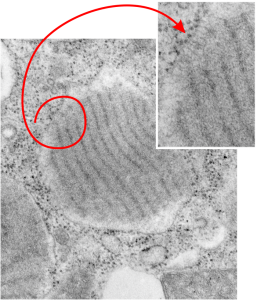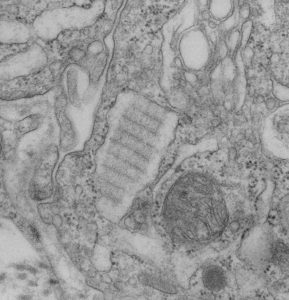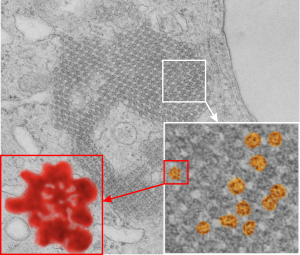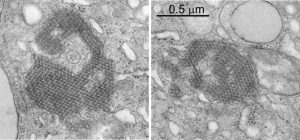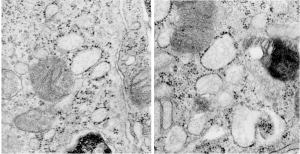Electron lucent areas just beneath the RER limiting membrane alveolar type II cell, these have ribosomes and layered protein, just like the previous post. I suspect it has to do with the proximity of ribosomes to the protein beneath, and the lucent areas just seem not to have close-by ribosomes. The red circle highlights which part of the intracisternal body is being noted, and the arrow head points to the insert and enlargement of that arrow. As before, the original large image is unretouched while the inset has been “burned” in the area that I want you to see, which includes the more electron dense area and adjacent more lucent areas, and the ribosomes. This is an alveolar type Ii cell from a ferret, magnification is 19,500, enlargement before scanning is 4 x. Final magnification can be more or less approximated by the size of the ribosomes (reportedly 20-30 nm) which makes the dark bands within the intracisternal body separated by a distance of about 100 nm.
Category Archives: Layered intracisternal protein granules in mammalian lung
Electron lucent areas just beneath the RER limiting membrane
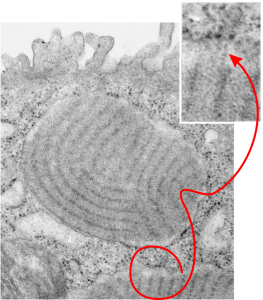 Electron lucent areas just beneath the RER limiting membrane seem to be a feature of very large and complex intracisternal bodies (ICB) (or RER SP granules if you prefer to give them a name that is what I think they may be (that is surfactant protein granules, backlogged in the RER for some reason)) This particular ICB has all the earmarks of the same layered striations seen in guinea pig and dog (this is from ferret, and is way more abundant that typically found and more curvey as well, 6911, 23303 19,500 original mag, 4 times enlargement plus whatever playing i did in Photoshop to crop and enhance contrast).
Electron lucent areas just beneath the RER limiting membrane seem to be a feature of very large and complex intracisternal bodies (ICB) (or RER SP granules if you prefer to give them a name that is what I think they may be (that is surfactant protein granules, backlogged in the RER for some reason)) This particular ICB has all the earmarks of the same layered striations seen in guinea pig and dog (this is from ferret, and is way more abundant that typically found and more curvey as well, 6911, 23303 19,500 original mag, 4 times enlargement plus whatever playing i did in Photoshop to crop and enhance contrast).
Noted here is the pale area beneath the cisternal membrane (RER membrane) which waxes and wanes around the central layered protein area which is considerably more dense than the pale areas. And then in occasional areas where ribosomes are present on the outer edge of the membrane, there can be some streaky connections (see inset) and a little bit of increased electron density in that electron lucency. In the inset the ribosomes, 3 of them, and streaks, 3 of them, have been “burned” using photoshop… the larger and original image was not “burned” in that area and the densities can still be easily seen (red lasso around the area that is enlarged for the inset which lies at the end of the arrow tips).
Anatomy of a really bad diagram
It is a common problem for scientists to be unable to communicate ideas, problems, discoveries, hypotheses and conclusions to colleagues and laity. I think it is because there are so many levels of “knowing” something. Not all people can translate knowledge into pictures. That sounds like a silly statement, but personally, there are many ways that I “know” the cells and tissues that I work with – but mainly I know them “visually”, and I have many many colleagues who “know” cells in a different way, and really have no clue as to whats going on structurally, or where.
I see this disconnect when one of my colleagues says something like – “we found this in liver” or we see this in “skin” or the changes are in “lung”…. what!!! that is completely wasted talk, there is no information in those statements, at least for me. I think of liver as a mix of parenchymal cells, supporting cells and systems (venous and arterial and neurological), matrices and architectural components, secretory and excretory elements, immune and detoxication apparati, protein production, carbohydrate storage, not to speak of all the myriad and wonderful ultrastructural components of each cell type, such as hepatocytes, duct cells, endothelium, that most individuals have never seen. I could go on and on…. in all humility…. I know nothing about liver, but apparently, neither do they. There is no useful information in the word “liver”, at least to me. Saying “liver” is like saying “someday” to a person who is asking for a specific point in time to be declared.
Similarly, after many years of working on the mouse back skin models of carcinogenesis I began to dread hearing others talk about “skin”…. Skin is a complex organ system, and conservatively speaking, has a dozen unique cell types, and about as many functions known to date, and many many more unknown. This has come to be true of every organ and tissue and cell type I have looked at through the electron microscope. And just for the record, in so many ways, cell cultures just don’t function like, or look like, cells in situ, that I just cringe when the parallels are drawn. Yes, I confess, we all learn from reducing systems to their lowest common function… I understand that.
So the bottom line here is that a “careless use of words can cause confusion BUT a careless diagram causes 1000 times more confusion“. Shall I list the ways the image below causes me grief.
- The alveolar type II cell is not a box, though diagrams giving it a cuboidal shape are usually acceptable, this one is not. The alveolar type II cell (as this box doesn’t represent (below)) has distinct plasmalemmal portions which have very different functions and morphologies, e.g. the apical (microvillar) area that interfaces with the alveolar space, and the basal or plasmalemmal side adjacent to the basement membrane, and the cell-cell lateral membranes as well, none of which is pictured or identified in the diagram below, thus creating a false impression of the cell membranes. In fact the lamellar body pictured inthe diagram is positioned such that it looks closer to what I would be inclined to assume is the lateral plasmalemma, than the apical membrane, which is completely erroneous since lamellar bodies are exocytosed from — and surfactant components are recycled from — the apical membrane.
- The nucleus here is completely wrong. There are no breaks in the inner and outer nuclear membrane, nope, and the only punctuations in the nuclear envelope (composed of the inner and outer membranes and the perinuclear space) comprise nuclear pores, which makes the nuclear membrane continuous not dashed. No breaks as pictured below. Yes the perinuclear space and outer nuclear membrane are intermittently continuous with the RER, this is true, but I have never in 40 years seen a stretch of continuous RER that almost completely encircles the nucleus as alluded to in the diagram just below the nucleus… this is careless, and false information about alveolar type II cells where the RER is normally short flattened cisternae.
- It would be wonderful if when diagrams like this are prepared for publication if someone made a decision to either use 3D or 2D and stick with it. (Similar issues are seen when in writing a manuscript, the author jumps from present, to future, to past tense..ha ha) Case in point: the cylindrical objects for two transport proteins are picture in something that is supposed to be 3D (no attempt at using a structure that might actually look something like the protein they are depicting) and 2D for the remaining structures. They give prime time to the one transporter for phosphate and this erroneously gives the impression that this is the only channel, transporter, or pump that is relevant in type II cells homeostasis which is totally wrong. And even if one declares it was done for simplicity’s sake, this doesn’t hold water since the disease that a malfunction of this sodium/phosphate transporter protein might produce is quite rare (according to the authors) so to give it so much press seems silly.
- It has been my observation that the nuclei in the type II alveolar cells is more central and basal than off in the corner, so this is misinformation as well.
- The appearance of lamellar bodies can be close to the base of the cell, on the sides and also in the apex, but clearly the exit is from the apical membrane in all likelihood so the position of this lamellar body might have been better placed nearer whatever membrane portion was supposed to represent the apex. Judging by the blue arrow, pointing to the electron micrograph (which could have been much much larger for clarity) shows the lamellar body exiting the cell in the lateral membrane, which of course is wrong.
- When diagrams of lamellar bodies are made, one could quite easily approximate the “real look” of lamellar bodies, which as the name suggests contains many many lamellae….and often is as much “empty” space as lamellar space, so why for goodness sake is this lamellar body shown as a solid object? That is just missed opportunity to provide useful and accurate visual information, rather than the information that is portrayed…. which is just inaccurate.
- As for putting in the diagram the golgi apparatus, (yep i should have used a capital for the G in golgi, as identified in 1897 by Camillo Golgi, but too long ago to be a relevant decoration) as the ONLY pathway for proteins from the RER and the only pathway from golgi to multivesicular bodies is much too restrictive. Mature lamellar bodies can be found in all quadrants of the cell, though some propensity exists for larger more mature lamellar bodies to be found at the apical membrane, many are found laterally and basally, which then renders the diagram below, inaccurate once more.
- A small comment, Type II alveolar cell, vs alveolar type II cell…. a little backwards in terms of convention. and I have done it as well, but stating the organ or tissue location is a good idea before naming the cell subtypes, especially since there are other types of type II cells. In a quick google search 53 occurrences of alveolar type II cell, vs 3 (one of which is mine, sadly) of type II alveolar cell, and quite a few times, type II pneumocyte, and sometimes lung type II cell. Convention is not always good, but in this case probably would have been nice.
- The long intracellular distance the lamellar body has to traverse to exit what should have been the apical membrane (but here the exocytosis will occur on the wrong side (laterally) in this diagram and likely an inadvertent choice for the position of the arrow) is not consistent with what is seen microscopically, in addition, the electron micrograph in this diagram (the tiny black and white picture to the right of the box-cell) is tubular myelin, which in this particular instance is a very unusually large amount that is not often seen that way. This is a false indication of what surfactant actually looks like in the alveolar space of the cell fixed for fine structure…. in fact in these researcher’s own publications, surfactant with NO surfactant protein A, has NO tubular myelin at all, yet they reported no respiratory distress…. thus the image is generates false information while making a point. The scrambled looking surfactant more typically seen, with only tiny amounts of tubular myelin, is still perfectly functional surfactant, and the unorganized stuff is actually much more abundant in micrographs than the would be assumed from the tubular myelin inset below. I am not sure why one would even want to suggest that all surfactant looks like tubular myelin.
- Just to the right of the tubular myelin is a cartoon of a lipid bilayer. That diagram is most typically used to represent a cell membrane (plasmalemma) and in this case it is repeated…a large and a reduced version…. what? First of all, this lipid bilayer is not in any way what the lamellar and tubular myelin surfactant looks like. That lipid bilayer doesn’t have any proteins attached…. functional surfactant (by these authors many publications) has protein components, partly for structure partly for function, partly for other purposes (breakdown, recycling, innate immunity, others about which I do not know — but they probably do). The question is “why use this model of a cell membrane bilayer as a model of “what” do they really mean this should represent surfactant within the alveolus? There is so much misinformation in that depiction I can hardly tell what the purpose of the diagram (and its miniature friend) was.
- OK, here is an odd comment, but what was the purpose of the red arrow from the alveolar space back to the multivesicular body? And what was the purpose of the word “catabolism” — just silly redundancy. Who in life doesn’t understand the word recycling? Doesn’t that suggest taking apart and repurposing, AND to suggest that all surfactant is recycled through the multivesicular body…. yikes, there is a real leap, that cannot be substantiated by any electron micrographs of alveolar type II cells I have ever seen. I will have to check the position of multivesicular bodies (I won’t take time to quantify any results or create a dataset, but just from my observations, MVB are neither sufficiently frequent, nor sufficiently large to accommodate the volume of turnover, though they repurposing of some components of the uptake of surfactant from the alveolar space might well get shuttled off to MVB in those low amounts.
- So if the Abca3 transporter moves DPPC into lamellar bodies, this diagram suggests that it does so from the cytoplasm (but I think that this is moved through the membranes. OK, more later.
- OK, so i am bored of this now, I am certainly grateful that they didn’t deem it necessary to add the diagram of an alveolar macrophage. That might have triggered another rant. Best to all these authors, each of whom I have met. But this was a great exercise for me, and a wakeup call to all you scientists who think that you can carelessly slap together a box and a few ovals and a label or two and do any one any favor. This was clearly only accepted for publication by reputation, not by information.
Odd protein accumulation within type II cell of an aged guinea pig
Ultrastructure shown here of more unusual protein structures within the RER of type II alveolar cells, these are really not at all like what I have been thinking are SP-A, but are more like fuzzy balls. The dimensions of the rounded electron dense accumulations within the cisternae of RER within this type II cell are about the dimension of 100+ nm. The comparison in size between three ribosomes from this same image (see the inset in lower right at actual size) and three of the fuzzy balls? perhaps, in the same inset at actual size, and then see the two types of structures, i.e. the ribosomes and the fuzzy balls enlarged to the same degree and pseudocolored in the inset to compare their relative sizes. The ribosomes are supposed to be something around 20-25-30 nm in that range, and if these are fuzzy balls (that would be multimers of surfactant protein D) then the fuzzy balls should be about three diameters compared to the ribosomes. Doesn’t quite work out, so the identification of these electron dense objects within the cisternae of RER in this electron micrograph is up for grabs. Nucleus is pseudocolored blue, nuclear pore, green, RER profiles with the odd protein, orange, actual size ribosomes and fuzzy balls grey, in inset, and enlarged in relative size, ribosomes, blue, fuzzy balls red.
Rough endoplasmic reticulum, ribosomes, and protein synthesis
Pseudocolored electron micrograph depicting what I think is 4 separate actual protein transcription events within an RER profile — see as four ribosomes on the RER membrane and the resulting 4 strands of protein within the lumen of the RER. The RER cisternal profile is pseudocolored cyan, the ribosomes (4 of them in particular) are blue, the proteins being synthesized, 4 of them, from adjacent ribosomes are in red, and the extracellular space beside the type II alveolar cell (from a ferret) is brownish, and the type II cell cytoplasm itself is a light violet color. This was an accidental find while perusing hundreds and hundreds of type II cell electron micrographs from a half dozen species of mammal.
This particular micrograph was not taken FOR this purpose, but it illustrates a point in time frozen by fixative and plastic three decades ago.
Ferret type II alveolar cell RER showing parallel bands in organization of intra-cisternal protein
How awesome is this particular view of an intracisternal protein in a ferret type II alveolar cell. The bands are slightly tangential and so only the most electron dense banding is seen, however, the interesting thing here is that on the periphery there is not really any banding, but it looks as if the banding occurs centrally in the granule (aka within the profile of the RER). Also, in the upper left of this electron micrograph (in an adjacent type II cell) examine closely the profile of RER which actually can be perceived as ribosomes on the membrane surface and the trails of protein hanging off in the RER lumen. Really a classic text-book presentation in “real life” so to speak, though we all know that TEM captures only a “nanosecond in time”, and all proteins are “fixed” and so distorted. Nevertheless, this may be one of those opportune views.
The protein (which I think is SP-A) is central in the micrograph, the banding pattern is at about a 35 degree angle. Ribosomes are present on right and left borders for the most part, smooth ER is in the upper right corner and there is a tiny portion of a lamellar body off on the right side. A portion of intercellular space with a couple of plasmalemmal folds crosses from top center to bottom left. There are a few other profiles of RER without SP-A? banding as well.
Type II alveolar pneumocyte of an owl monkey: electron micrograph
Still going through all the transmission electron micrographs of alveolar type II cells from 40 years of photography. Here is one print from an owl monkey (no treatment) I pseudocolored with yellow-brown for the nucleus, red for the nuclear pores, blue for the lamellar bodies, cyan (green) for the cytoplasm. Just for the record, i did not find any protein structures within the RER which might be construed as intrcisternal layered RER inclusions that one wants to see if one is looking for SP-A.
5 year old mongrel dog lung endothelial or alveolar type II epithelial cell? inclusion
From the previous post, I did some more searching on the very ordered protein inclusion in the type Ii cell of a mongrel dog (5 yr old). The orderly array looked to me like a bunch of hexagonal structures with a central dot. When I made measurements (comparing the magnification, enlargement and pole piece used at the microscope, I figured out what about 500 nm would be, and then 50 nm seemed to be almost exactly twice as big as each of these hexagonal flower (bouquet) structures. They might not actually be octadecamers (as is often found for SP-A )- and a shadowed image of one such shadowed SP-A molecule from a publication by T. Voss, H. Eistetter, KP Schafer in J. Mol. Biol, 1988, 201: 219-227, which i have cut out, pseudocolored in photoshop, cut out, and placed along side one of the bouquets in the ordered protein inclusion in this particular cell. Since I could not identify the cell specifically, one only can guess as to what it might be.
nb. since this blog, I found a similar micrograph of dog lung, in a paper by Stephens, Freeman, Stara and Coffin, Am J Path, 73: 711-726, 1973 which identified a very similar structure (cuboidal organization) in endothelial cells (they say)(Figs 14-16 in their publication). I cannot identify the cell in my micrograph as an endothelial cell, but can confirm that there are dense coated vesicles (at least 11 in this image) just like they found in their micrograph., and one edge of the cell in my micrograph is adjacent to collagen fibers. This would make the cell either epithelial or endothelial. It has no lamellar bodies and no nuclear profile, and only two kind of iff-ish mitochondria.
Circles identify the two molecules (one SP-A according to Voss et al, the other a similar sized protein (could be an octadecamer?? just making a guess here) or some other order of –merization. In the two images (see previous post) there were literally hundreds of times that one could visualize a bouquet with center point as the one enlarged in the inset, and pseudocolored a purple. One of the perplexing things is that when one begins to see structures in a repeated design like this…. many more can be pointed out, and then one wonders what is imagination and what is fact (that is the great tendency of the human brain to become immediately biased).
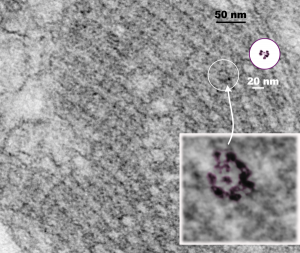 So after finding this in the publication by Stephens et al, 1973, I decided to scan another area of that same cell and enlarge a portion, and highlight some structures (as above) which look like a multimer of SP-A in a lattice formation and post it here again. Would love to say I could count 18 blobs to depict the carbohydrate recognition domains (haha). I highlighted the “spokes” found in the inclusion below, I should have seen them in the inset inclusion above, but did not highlight them… however, they are there.. maybe 6 of them in top, maybe 7 in bottom inset. The configuration here , globby tops, skinny necks and central dot is pretty reminiscent of how the bouquet of SP-A is diagrammed.
So after finding this in the publication by Stephens et al, 1973, I decided to scan another area of that same cell and enlarge a portion, and highlight some structures (as above) which look like a multimer of SP-A in a lattice formation and post it here again. Would love to say I could count 18 blobs to depict the carbohydrate recognition domains (haha). I highlighted the “spokes” found in the inclusion below, I should have seen them in the inset inclusion above, but did not highlight them… however, they are there.. maybe 6 of them in top, maybe 7 in bottom inset. The configuration here , globby tops, skinny necks and central dot is pretty reminiscent of how the bouquet of SP-A is diagrammed.
5 year old mongrel dog lung RER inclusion ???
These accumulations are found in the peripheral lung of a 5 year old dog that was part of research for an entirely different topic. The identification of the cell was not really possible, there were not absolute defining features, except there were mitochondria, perhaps a lipid droplet (cell membrane is obscure around this area), dense coated endocytic vesicles, rough endoplasmic reticulum, and it is adjacent to a cell(s) with microvilli, basement membrane, and alveolar space. What it is, I have no clue.
neg 9931, blcok 24669, dog 5 yr, original mag 21750 x 4 pole piece V seimens 1A
Microvillar cell in the olfactory epithelium and alveolar type II cell in lung: RER look-alike
Thinking about dendritic cells, in general, which participate in innate immunity as I have done recently because of my efforts to put a “name” on the protein responsible for the layered RER granules in some alveolar type II cells. I have searched the micrographs of many tissues which I have examined over 40 years, and the widespread similarities in morphology, one cell to the next – because of similar mechanisms for producing – importing – exporting – secreting – excreting -recycling – removing – transferring – deleting – various “products” as granules – proteins – factors – hormones – etc, are pretty interesting. In particular, such varied products come from such uniform mechanisms of production. Case in point — the microvillar cell of the olfactory epithelium (which I happen to think is a dendritic cell with functions related to innate immunity) has RER which in someways is a dead ringer for the RER of the alveolar type II cell in some of my guinea pig micrographs with RER granules that appear to be overproducing some protein — likely a surfactant protein, either A or D. See below…. Only by the presence of a lamellar body can these two cell types be distinguished… in particular RER profiles can often be amazingly similar (OR — alternatively are the protein products amazingly similar – maybe both are c type lectins). IF YOU FIND THE LAMELLAR BODY you will know which is which… LOL — I’ll never tell.
It is my hope that at some point the protein being secreted by the microvillar cell of the olfactory epithelium is a c-type lectin just like at some point the protein in my guinea pig type II cells will be determined to be surfactant protein A or D or both. I did hunt vigorously for any layering and periodicity in the former, but did not find any in my images, but found literally thousands of examples in the type II cells (see previous posts).
